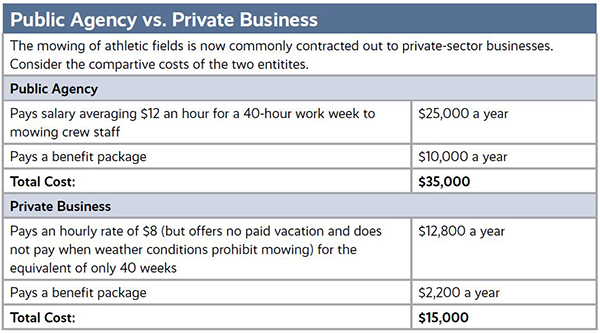
For an enhanced digital experience, read this story in the ezine.
The most obvious contribution the private sector can bring to park departments is an ability to invest funds for operation, maintenance and/or capital development. However, there are four additional aspects of private-sector involvement that may be attractive to park and recreation agencies: specialized management and technical expertise, reduced labor costs, adaptability to scale of services, and reduced liability risks.
Access to Private Capital
The private sector can act quickly once a pro forma shows a venture is likely to receive a desired return on investment. In contrast, for a park department to secure capital it usually has to engage in an extended process of soliciting broad public participation and input; lengthy legislative approval procedures; extended budget hearings, and residents’ affirmation in a referendum.
This lengthy process makes it difficult to respond to unanticipated opportunities that arise in the marketplace. However, this is the milieu in which a business operates, so it is well-equipped to act expeditiously. In these situations, a department may make a potential private partner aware of an opportunity and of the complementary assets the agency can provide to assist in bringing it to fruition.
Specialized Management and Technical Expertise
Sometimes recreation departments do not have personnel with the training, experience and/or equipment to effectively manage specialized facilities (e.g., skate parks, concessions). Businesses that specialize in these areas are able to draw upon an array of marketing skills and resources, cost controls and other systems that have proven effective in similar facilities, and a focused workforce with experience and strong technical expertise. Thus, partnering with them is likely to be an effective and efficient option.
Recreation departments typically provide programs designed to offer opportunities for self-development, self-expression, self-improvement, character development and social interaction. However, the recreation preferences of many individuals lean toward escapism, fantasy or role playing. These preferences are reflected in the popularity of esports, computer games, virtual reality simulation, television, social media, spectator sports, urban entertainment centers, spas and resorts. Again, management of these types of services is not within the skill set of many recreation professionals, whereas the private sector has expertise in developing and operating facilities that offer these kinds of benefits.
Reduced Labor Costs
The labor-intensive nature of many park services makes personnel the major cost center in service delivery. Departments typically pay an additional 30 to 35 percent of an employee’s salary for fringe benefits, such as health insurance, retirement, sick leave and maternity leave. Many businesses do not, which enables them to provide the same level of service at a lower cost.
Who Are You Going to Hire to Mow Athletic Fields?
Most departments now outsource routine low-skilled activities, such as mowing. The advantages are illustrated in the chart below. This decision poses a moral dilemma for those of us who are elected officials. Is it morally appropriate for me to vote in favor of outsourcing because it is much cheaper, when I know that the business that wins the contract will be paying much less than a living wage? Elected officials will reach different conclusions.
Adaptability to Seasonality and Scale of Service
In some situations, a department’s labor force is not well-matched with the seasonality of many programs. For example, an audit of my city’s aquatic program noted, “Even though 83 percent of the aquatic revenue is collected in June, July and August, and another 12 percent in April and May, almost 50 percent of aquatic personnel cost is incurred during months when the city pools are closed. Discontinuing the staffing of the pools during the off-season would generate around $250,000 in cost savings.”
Private partners are better equipped to deliver services that require a large number of part-time employees for short time periods. Bureaucratic procedures for hiring and paying part-time staff are frequently lengthy, cumbersome and onerous, whereas it is generally easy for businesses to do this.
Expenditures on specialized equipment is difficult for an agency to justify if use of the equipment is seasonal, so it sits idle for much of the year. A business serving multiple organizations is likely to have economies of scale that enable it to purchase state-of-the-art and specialized equipment at a lower price than a department with only a single facility.
For example, each year, American Golf Corporation purchases more than 3,000 golf carts for the 250 courses it operates. The volume enables the company to negotiate a substantially lower purchase price per cart than any single department could.
In addition, private partners can often take advantage of federal business tax laws that permit rapid depreciation of new equipment and offer investment tax credits for its purchase.
Reduced Liability Risks
Governments have deep pockets. This makes them an attractive target for contingency liability suits arising from allegations of reckless acts (negligence) that result in unintentional harm to a third party. Because liability insurance premiums are largely based on the estimated level of risk, departments seek to transfer their liability exposure to private partners.
Typically, agreements include clauses stating the agency will be “held harmless” in the event of a negligence claim. Since this does not always provide ironclad protection, an indemnity clause usually is added stipulating that if the hold harmless clause is not completely adequate, the partner (or its insurer) would pay for any damages the agency owed.
John L. Crompton, Ph.D., is a University Distinguished Professor, Regents Professor and Presidential Professor for Teaching Excellence in the Department of Recreation, Park and Tourism Sciences at Texas A&M University and an elected Councilmember for the City of College Station.


